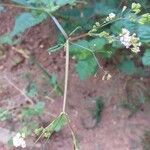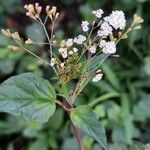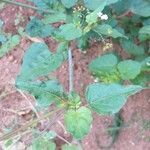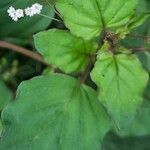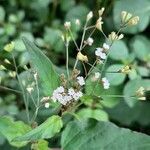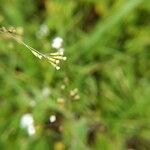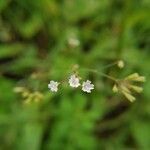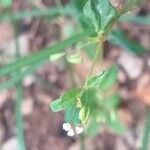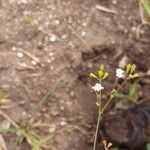Stems decumbent or prostrate, puberulent, with scattered long septate hairs. Leaves with petioles (5-)6-34(-35) mm long; lamina oblong, lanceolate, elliptic, deltoid or ovate, (15-)20-47(-51) x (10-)12-25(-29) mm; apex apiculate, acuminate, acute or obtuse; base shortly attenuate, obtuse or truncate; margins entire, sometimes undulate; glabrous, sometimes with long septate hairs along margins and veins. Inflorescence with primary peduncles ±115 mm long, secondary peduncles 55-65 mm long, glabrous to puberulous; 4-10 flowers per cluster; pedicels 1 mm long. Flowers 2-3 mm long; lower part of perianth 1-2 mm long, clavate, 5-ribbed, glabrous; upper part of perianth 1 mm long, pink, purple or white. Stamens 2, slightly exserted, 2-2.5 mm long. Ovary 0.5 mm; style 1-2 mm long. Anthocarp 3-4 x 1-2 mm, clavate, 5-winged, wings slightly undulate along margins, apex truncate, ending in pointed tip, glabrous.
Annual or perennial herb, branching freely from base, spreading. Stems decumbent to prostrate, puberulous with scattered, long, gland-tipped hairs around nodes, sometimes viscid. Leaves 15-51 mm long, oblong, lanceolate, elliptic, deltoid or ovate, glabrescent to sparsely pubescent, discolorous, usually distinctly reddish brown glandular-punctate on both surfaces, base shortly attenuate, obtuse or truncate, rounded ± truncate; petioles 5-35 mm long, pubescent or pilose. Inflorescence a terminal, compound cyme, usually freely branched; peduncles glabrous to puberulent. Flowers minute, campanulate, up to 2.5 mm long. Perianth lower part green, coriaceous, clavate, 5-ribbed, persistent upper part of flower petaloid, pink, purple or white. Ovary 0.4-0.5 mm long, glabrous; style exserted. Flowering time Oct.-May. Fruit 3-4 mm long, 5-ribbed, obscurely undulated along the margins.
Annual, ascending or erect herb up to 1 m., with a stout rootstock.. Stems fleshy, becoming woody towards the base, green, often flushed with red, glabrescent to pubescent, branching mainly from the base, the nodes swollen.. Leaves broadly ovate to lanceolate, up to 7.5×7 cm., green above, greyish-white beneath, sometimes tinged purple, the base truncate to cuneate, the apex rounded to acute or rarely acuminate, margins sinuate, occasionally red tinged.. Inflorescence a large diffuse terminal panicle up to 65 cm. long, the individual cymes (1–)4–5(–8)-flowered.. Perianth 1.5–3.5 mm. long, up to 2 mm. wide; upper portion white to pale pink, sometimes with darker stripes, 1–1.5 mm. long.. Stamens 2(–3), slightly exserted.. Ovary ± 0.5 mm.; style 1–2 mm. long, slightly exserted.. Anthocarp obconical, 3–4×1–1.5 mm., 5-ribbed, truncate at the apex, glabrous.. Fig. 1/5.
Annual herbs; stems erect or ascending, 2-8 dm. tall, rather slender, glabrous or essentially so. Leaves opposite or subopposite, often unequal at the nodes, petiolate; blade rather irregularly ovate-rhombic, obtuse to rounded, or infrequently acute, at the apex, broadly obtuse to rounded at the base, undulate or sinuate, 2-9 cm. long, 1-4 cm. broad, glabrous or essentially so, yellowish green above, paler and more or less conspicuously bracteate, glabrous or essentially so. Flowers in pedunculate 2-to 3-flowered dichasia, distinctly pedicellate, the perianth tube 1.0-1.5 mm. long, about 0.5 mm. broad, herbaceous, glabrous, the perianth limb campanulate, about 0.5-0.7 mm. long, white or pink; stamens 2-3, slightly exserted. Anthocarps obpyramidal, truncate, glabrous, 3-4 mm. long, 1.0-1.5 mm. broad, borne upon accrescent pedicels of about equal length.
Herb, 20-80 cm, erect or decumbent at the very base, puberulous, especially in the upper part at the nodes, glabrescent. Leaves 1.75-3.5 by 1-2.25 cm, ovate, oblong, or lanceolate; base rounded to truncate; lower surface mostly white and with sunken red glands; top acute, rarely obtuse; petiole 1.5-4 cm. Flowers 2-3 together in cymose panicles, 1-2.5 by 1.5-3.5 cm, 1-3 times branched; peduncle 1.5-2 cm; tubular-campanulate; pedicel ½-5 mm, with 1-2 lanceolate bracteoles 0.75-1 by 0.25 mm at the top or lower on the pedicel. Perianth 1.75-2.5 mm, with 5 faint ribs and a distinct constriction halfway; limb 1.5-2 mm, white, red, or pink. Stamens 2-3, exserted for 0.5 mm, like the stigma. Anthocarp obconical, glabrous, 3-3.75 mm long, top truncate, the groove between the 5 ribs somewhat undulate.
Herbs. Stems erect or decumbent at base, 20-80 cm, puberulous or glabrescent. Petiole 1.5-4 cm; leaf blade ovate, oblong, or lanceolate, 1.5-3.5 × 1-2.5 cm, abaxially white-gray, with sunken glands, base rounded or cuneate, margin with unicellular hairs, apex acute, rarely obtuse. Inflorescences mostly axillary, cymose panicles close together; peduncle to 2 cm. Pedicel 0.5-5 mm, with 1 or 2 lanceolate bracteoles. Perianth limb white, red, or pink, 1.5-2 mm. Stamens 2 or 3, slightly exserted. Anthocarp obconic, ca. 3 mm, glabrous, 5-ribbed, groove between ribs somewhat undulate, apex truncate, angular. Fl. and fr. summer.
A herb. It becomes a perennial weed. It can be 1 m tall and either upright or lying over. The leaf stalk is 1.5-4 cm long. The leaves are stalked, opposite, and variable in shape and size. They are 1.5-3.5 cm long by 1-2.5 cm wide. They are white-grey underneath. The flowers are produced in the axils of leaves. The fruit is cone shaped. It is about 3 mm across.
Semi-erect, soft herb, up to 0.35 mm high; plants unarmed. Leaves with blade broadly ovate, 13-65 x 4-60 mm, distinctly reddish brown punctate. Flowers: in terminal cymes, ultimately diffusely paniculate; stamens ± exserted; perianth cylindrical, relatively small and inconspicuous, purple; Oct.-Jan. Fruit eglandular, 5-ribbed, truncate at apex.
Leaves 1.3–6.5 × 0.4–6 cm., narrowly to broadly ovate, base subcordate, rounded, more or less truncate or broadly cuneate, apex acute to obtuse, sometimes apiculate, glabrescent to sparsely pubescent, discolourous, usually distinctly reddish-brown glandular punctate on both surfaces; petioles up to 2 cm. long, pubescent or sometimes pilose.
Stems prostrate, decumbent or ascending, glabrescent to pubescent, often with scattered longer septate hairs particularly around nodes, sometimes viscid.
Semi-erect, soft herb, up to 350 mm tall. Stems puberulous. Leaves broadly ovate. Fruit eglandular, 5-ribbed, truncate at apex. Flowers purple.
Perianth 1.5–3 mm. long, glabrous, lower portion, 5-ribbed, upper portion 0.8–1.5 mm. long, campanulate, magenta, pink, mauve or white.
Inflorescences terminal, cymose, ultimately diffusely paniculate; peduncles glabrous to puberulous, sometimes glandular.
Anthocarps 3–4 × 1–1.2 mm., turbinate, apex broadly obtuse or truncate, eglandular, glabrous; ribs 5, acute.
Flowers usually 2–5 (10) per cluster, sessile or with pedicels up to 2 mm. long.
Ovary 0.4–0.5 mm. long, glabrous; style 1.25–2 mm. long, slightly exerted.
Annual or perennial herbs, branching freely from base, spreading.
Stamens 2–3, 2–2.5 mm. long, subequal, slightly exerted.
Bracteoles 1–1.5 mm. long, lanceolate, ciliate.
